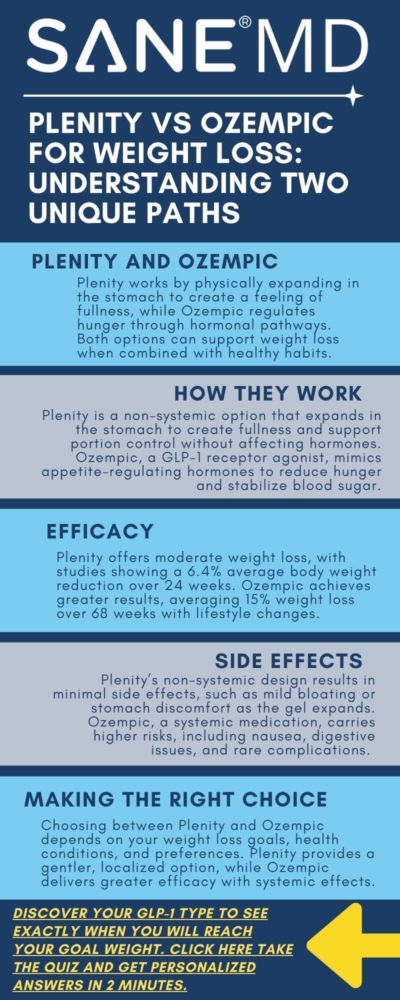Plenity vs Ozempic for Weight Loss: Take the Quiz Now!
Dr. Matthew Olesiak, MD, is the Chief Medical Director at SANESolution, a renowned wellness technology company dedicated to providing evidence-based solutions for optimal living. Dr. Olesiak earned his medical degree from the prestigious Jagiellonian University Medical College in Kraków, Poland, where he developed a strong foundation in medicine.
Plenity and Ozempic are two prescription weight loss options that cater to individuals seeking support in managing their weight and preventing weight gain. While both weight loss treatments can help you lose weight, they work in fundamentally different ways. Plenity is a non-systemic option designed to mechanically create a feeling of fullness in the stomach, whereas Ozempic is a GLP-1 receptor agonist that regulates appetite through hormonal pathways thus potentially affecting metabolic health generally.
This article compares Plenity vs Ozempic for weight loss to help you determine which option may align with your weight loss needs and lifestyle. Remember, weight loss drugs aren’t one-size-fits-all. Consulting a healthcare provider is essential to find the safest and most effective solution tailored to your health profile. There are plenty of Plenity questions that need to be answered. as well as those for Ozempic, so let’s get to it.
Key Takeaways
- Plenity: A non-systemic option ideal for creating a feeling of fullness with fewer side effects.
- Ozempic: A GLP-1 receptor agonist effective for weight loss, chronic weight management, and managing blood sugar levels.
- Suitability: Depends on factors like health conditions, weight loss goals, and personal preferences.: Take the Quiz Now!
Overview of Plenity Vs Ozempic for Weight Loss
What is Plenity?
Plenity is a prescription weight loss device aid approved by the FDA, specifically designed for adults whose body mass index (BMI) ranges from 25 to 40. Unlike traditional medications that alter metabolic or hormonal functions, Plenity is made of naturally derived cellulose and citric acid.
When taken with water before meals, the capsules expand in the stomach, creating a sensation of fullness. This mechanical action encourages portion control and reduces calorie intake without being absorbed into the bloodstream, making it a non-systemic option.
What is Ozempic?
Ozempic, developed to manage type 2 diabetes — one of the most prevalent digestive and kidney diseases — has not been FDA-approved for weight loss. Though not officially a prescription weight loss medication, healthcare providers are increasingly prescribing Ozempic off-label for weight loss in adults with obesity or overweight individuals with at least one weight-related health condition.
As a GLP-1 receptor agonist, Ozempic mimics hormones that regulate appetite and blood sugar levels. By slowing digestion and reducing hunger signals, Ozempic supports sustained weight loss while also helping to stabilize glucose levels, making it particularly beneficial for individuals with metabolic concerns.
Both medications are prescription-based, yet they differ significantly in how they function. To better understand which may suit your needs, consulting a healthcare provider and taking the weight loss drug type quiz can provide tailored guidance.
Mechanism of Action
How Plenity works
Plenity works mechanically, targeting fullness without altering metabolic or hormonal functions. Made of naturally derived cellulose and citric acid, the capsules are taken with water before meals. Once in the stomach, they absorb water and expand, forming a gel-like substance that occupies space.
This expansion triggers a feeling of fullness, helping individuals reduce portion sizes and calorie intake. Since Plenity isn’t absorbed into the bloodstream, it’s classified as a non-systemic option, making it suitable for a broader range of individuals.
How Ozempic Works
Ozempic operates on a hormonal level as a GLP-1 receptor agonist. It mimics the action of GLP-1 hormones, which are naturally produced in the gut, to regulate hunger and blood sugar levels. By acting on the brain’s appetite control center, Ozempic helps reduce cravings and suppress hunger.
Additionally, it slows digestion, ensuring glucose is released gradually into the bloodstream, which aids in stabilizing blood sugar levels. This dual action makes Ozempic particularly effective for individuals with obesity or type 2 diabetes.
Comparison Chart: Plenity vs. Ozempic
| Feature | Plenity | Ozempic |
|---|---|---|
| Mechanism | Mechanical expansion in the stomach | Hormonal regulation of appetite |
| Systemic/Non-Systemic | Non-systemic | Systemic |
| Primary Action | Creates fullness | Reduces hunger and slows digestion |
| Additional Benefits | No metabolic or hormonal impact | Regulates blood sugar levels |
These differences highlight the unique approaches of Plenity and Ozempic. If you’re unsure which might be the best fit for your weight loss goals, exploring options through the weight loss drug type quiz can provide helpful insights tailored to your needs.
Efficacy for Weight Loss
Plenity’s Effectiveness for Weight Loss
Plenity has shown promise as a weight loss aid in clinical trials. In a 24-week study, participants using Plenity in conjunction with a reduced-calorie diet and physical activity lost an average of 6.4% of their body weight compared to 4.4% in the placebo group.
While these results demonstrate moderate effectiveness, Plenity’s non-systemic approach makes it a safer option for individuals with specific health concerns.
Plenity is FDA-approved for adults with a BMI between 25 and 40, making it suitable for overweight individuals and those with mild obesity. Its focus on creating fullness without affecting hormones or metabolism makes it an appealing choice for those seeking a mechanical, rather than systemic, weight loss option.
Ozempic’s Effectiveness for Weight Loss
Ozempic has demonstrated significant weight loss benefits, particularly in individuals with obesity or type 2 diabetes. Studies indicate that patients using Ozempic lost an average of 15% of their body weight over 68 weeks when combined with lifestyle changes, outperforming many other weight loss medications. This effectiveness contributed to its FDA approval for weight management under the brand name Wegovy, specifically designed for obesity treatment.
Ozempic is particularly beneficial for individuals who need both weight loss support and blood sugar regulation. Its ability to reduce cravings, suppress hunger, and improve glucose control has made it a popular choice for adults with a BMI of 27 or higher who also have weight-related health conditions.
Is Plenity or Ozempic More Effective?
While Ozempic tends to deliver more dramatic weight loss results, its systemic effects and potential side effects may not be suitable for everyone. Plenity offers a gentler alternative with fewer side effects but may not achieve the same degree of weight loss.
Side Effects and Safety
Plenity Side Effects and Risks
Plenity is generally well-tolerated, with a low risk of significant side effects due to its non-systemic nature. The most common side effects reported during clinical trials include bloating, gas, and mild abdominal pain or discomfort. These symptoms are usually temporary and occur as the gel-like material expands in the stomach to create fullness.
Because Plenity doesn’t enter the bloodstream or alter hormones, it’s suitable for individuals with certain health conditions that might preclude systemic medications. However, it’s not recommended for people with a history of gastrointestinal obstructions or those unable to swallow capsules. As with any weight loss aid, consulting a healthcare provider is essential to assess safety and suitability.
Ozempic Side Effects and Risks
Ozempic, as a systemic medication, carries a broader range of side effects. Commonly reported issues include nausea, diarrhea, constipation, and injection site reactions. These symptoms often lessen as the body adjusts to the medication but can persist in some cases.
Rare but serious risks associated with Ozempic include pancreatitis, gallbladder issues, and potential thyroid tumors (observed in animal studies). Consequently, Ozempic is not advised for individuals with a personal or family history of medullary thyroid carcinoma or multiple endocrine neoplasia syndrome type 2 (MEN 2).
Studies suggest that Ozempic may help reduce high blood pressure, which can be a positive side effect of this medication.
Safety Considerations
While Ozempic may offer significant weight loss results, its systemic nature and potential risks make it less suitable for some individuals. Plenity, with its localized action, provides a safer alternative for those seeking a gentler option with fewer side effects.
If you’re unsure which medication aligns with your health profile, the weight loss drug type quiz can be a helpful starting point to explore options tailored to your specific needs. Always discuss your choices with a healthcare provider before beginning any weight loss medication.
Suitability: Who Should Consider Each Option?
Plenity
Plenity is an excellent option for individuals seeking a non-invasive and non-systemic weight loss aid. Its mechanical approach to creating fullness in the stomach makes it suitable for adults with a BMI between 25 and 40 who want to manage their weight without systemic effects on metabolism or hormones.
Because Plenity isn’t absorbed into the bloodstream, it may be safer for individuals with certain medical conditions, such as those who cannot tolerate medications that alter appetite hormones or metabolic processes.
However, Plenity is not suitable for individuals with a history of gastrointestinal (GI) obstructions, as the expanding gel-like material could exacerbate such conditions. Additionally, those unable to swallow capsules should explore other options.
Ozempic
Ozempic is well-suited for individuals with type 2 diabetes or significant weight loss goals. Its dual ability to regulate blood sugar levels and suppress appetite makes it particularly effective for people with obesity-related health conditions, such as hypertension or dyslipidemia.
However, Ozempic’s systemic effects and potential side effects mean it’s not suitable for everyone. Ozempic is not recommended for individuals with a personal or family history of medullary thyroid carcinoma or multiple endocrine neoplasia syndrome type 2 (MEN 2). Those with a history of pancreatitis should also avoid Ozempic, as it may increase the risk of recurrence.
Making the Right Choice
Choosing between Plenity and Ozempic depends on your health profile, weight loss goals, and personal preferences. It’s important to note that both options work best with a healthy diet.
Always discuss your choices with a healthcare provider to ensure the medication aligns with your medical history and lifestyle needs.
Cost and Accessibility
Plenity
Plenity costs approximately $98 for a one-month supply, making it a relatively affordable prescription option for weight loss. However, it’s worth noting that insurance coverage for Plenity is limited, as it’s not universally covered under weight loss benefits.
Patients interested in Plenity should consult with their insurance provider to confirm coverage or explore savings programs that may help reduce out-of-pocket expenses.
Ozempic
Ozempic is typically more expensive, with a monthly cost ranging from $900 to $1,200 without insurance. However, it’s often covered for patients with type 2 diabetes due to its dual role in managing blood sugar and promoting weight loss.
For individuals using Ozempic solely for weight management, insurance coverage may vary significantly. Manufacturer discounts and savings programs are available for eligible patients to help offset the high cost.
Affordability Considerations
Cost and accessibility can be deciding factors when choosing between Plenity and Ozempic. Exploring your options through the weight loss drug type quiz and discussing insurance coverage with your healthcare provider can guide you toward the most practical and affordable solution.
Frequently Asked Questions About Plenity and Ozempic
This FAQ section answers common questions about Plenity and Ozempic to help you make an informed decision. From understanding their differences to determining suitability, these answers will guide you in choosing the weight loss option that aligns with your health and goals.
What are the main differences between Plenity and Ozempic?
Plenity is a non-systemic, mechanical aid that expands in the stomach to create fullness, while Ozempic is a GLP-1 receptor agonist that regulates appetite and blood sugar levels through hormonal pathways. Plenity is taken as capsules with water before meals, whereas Ozempic is administered as a weekly injection. Plenity is suitable for adults with a BMI between 25 and 40, while Ozempic targets those with obesity or weight-related health conditions.
Which is more effective for weight loss, Plenity or Ozempic?
Ozempic has shown higher weight loss results, with studies reporting an average 15% reduction in body weight over 68 weeks when combined with lifestyle changes. Plenity’s effectiveness is moderate, with users achieving an average weight loss of 6.4% over 24 weeks. However, Plenity’s non-systemic nature makes it a safer option for some individuals.
Can I take Plenity or Ozempic if I have other health conditions?
Plenity is often suitable for individuals with certain health conditions due to its non-systemic nature. However, it’s not recommended for those with gastrointestinal obstructions.
Ozempic may be ideal for patients with type 2 diabetes but is contraindicated for individuals with a history of thyroid cancer or pancreatitis.
What are the most common side effects of Plenity and Ozempic?
Plenity’s side effects include bloating, gas, and mild stomach discomfort. Ozempic’s common side effects are nausea, diarrhea, and injection site reactions, with rare risks such as pancreatitis and gallbladder issues.
Is Plenity safer than Ozempic?
Plenity’s non-systemic approach generally makes it safer for individuals avoiding systemic effects. Ozempic, while effective, carries higher risks due to its hormonal mechanism and potential side effects.
How do I decide which option is right for me?
Choosing between Plenity and Ozempic depends on your health profile, weight loss goals, and preferences. Consulting a healthcare provider to discuss your options can help you make the best decision.
Can I use Plenity and Ozempic together?
Combining weight loss medications should only be done under medical supervision. Your healthcare provider can assess whether using both options is safe and effective for your situation.
How long does it take to see results with Plenity or Ozempic?
Plenity users may see results within a few weeks, with noticeable changes in 24 weeks. Ozempic generally requires consistent use for several months, with significant results occurring over 68 weeks.
Conclusion
Plenity and Ozempic are two distinct prescription weight loss aids, each with unique approaches and benefits. Plenity is a non-systemic option that works mechanically to create fullness in the stomach, offering a gentle option with minimal side effects. In contrast, Ozempic is a systemic medication that regulates appetite and blood sugar through hormonal pathways, often delivering more significant weight loss results but with a higher risk of side effects.
Choosing the right option depends on your health profile, weight loss goals, and personal preferences. It’s crucial to consult with a healthcare provider to identify which medication best suits your needs, ensuring safe and effective weight management.
Take the weight loss drug type quiz now to explore your options and discover which approach might be the perfect fit for your journey toward better health and weight loss success!





